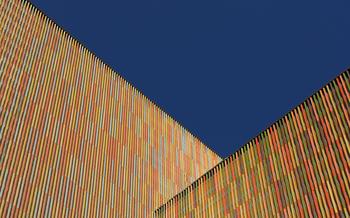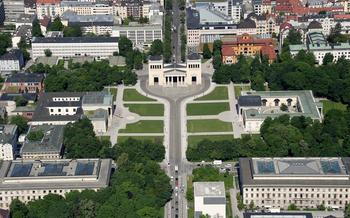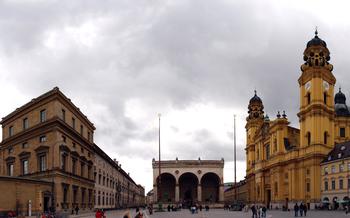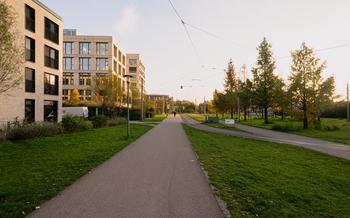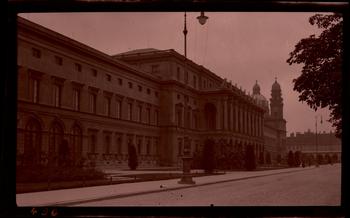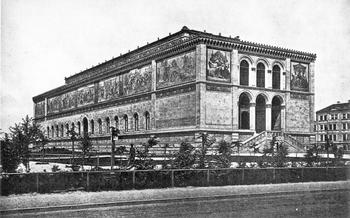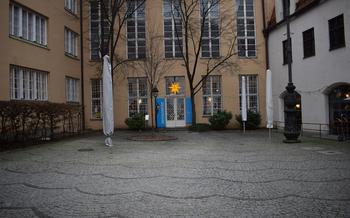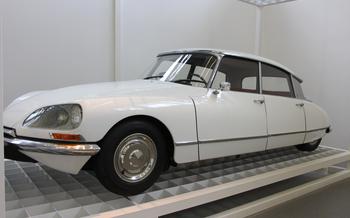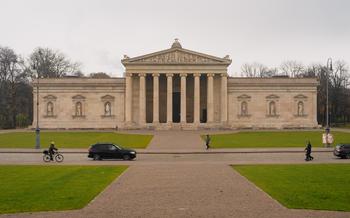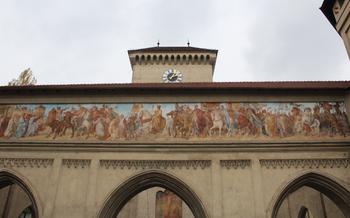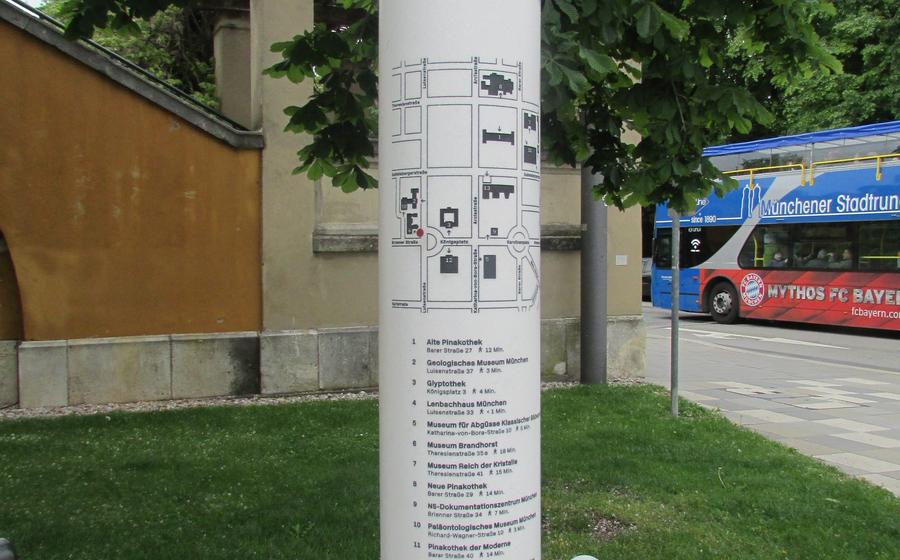
Kunstareal München
- Orientation and Background
- Architectural Splendor
- Three Pinakotheks, One Treasury
- Beyond Paintings
- A World of Antiquities
- Musical Delights
- Contemporary Masterpieces
- Museum Brandhorst
- Lenbachhaus
- Villa Stuck
- Hofgarten
- Neighborhood Charm
- Insider Tip: Guided Tours for In-Depth Exploration
Orientation and Background
Munich, the vibrant capital of Bavaria, is renowned for its rich cultural heritage and architectural splendor. At the heart of this cultural tapestry lies the Kunstareal München, an extraordinary district dedicated to the arts. This vibrant neighborhood is a treasure trove of world-class museums, galleries, and cultural institutions, attracting art enthusiasts and history buffs from around the globe.
The Kunstareal München traces its roots back to the 19th century when King Ludwig I, a passionate patron of the arts, envisioned a dedicated district for the preservation and appreciation of artistic treasures. Through his vision, the district emerged as a hub of cultural exchange, housing some of the most prestigious museums and galleries in Europe. Today, the Kunstareal München stands as a testament to the city's enduring commitment to the arts, showcasing a diverse collection that spans centuries and artistic movements.
The district is conveniently located in the heart of Munich, within easy reach of the city's iconic landmarks and attractions. Its proximity to the city center and excellent public transportation links make it easily accessible for visitors seeking an immersive cultural experience. Whether you're a first-time visitor or a seasoned art aficionado, the Kunstareal München offers a journey through time and artistic expression that is sure to captivate and inspire.
Architectural Splendor
The Kunstareal München is a testament to the architectural grandeur of Munich. The Pinakothek Museums, with their imposing neoclassical facades, dominate the skyline of the district. The Alte Pinakothek stands out with its elegant portico and triangular pediment, while the Neue Pinakothek features a colonnade and a glass-domed atrium. The Pinakothek der Moderne, the youngest of the trio, boasts a striking modern design with sharp angles and an abundance of natural light.
The Alte Pinakothek, built in the 19th century, is a masterpiece of Baroque architecture. Its grand entrance hall, adorned with intricate frescoes and sculptures, sets the tone for the treasures that await inside. The Neue Pinakothek, constructed in the late 19th century, showcases Renaissance Revival style with its symmetrical facade and arched windows. It is a testament to the architectural trends of its time.
Three Pinakotheks, One Treasury
The Kunstareal München is home to three world-renowned Pinakotheks, each dedicated to a different era of art. The Alte Pinakothek, the oldest and most famous of the three, houses a treasure trove of old masters' paintings from the 14th to the 18th centuries. Here, visitors can marvel at masterpieces by Albrecht Dürer, Peter Paul Rubens, and Rembrandt.
The Neue Pinakothek, housed in a splendid building with a Renaissance Revival facade, showcases 19th-century art. This museum boasts an impressive collection of works by Caspar David Friedrich, Claude Monet, and Vincent van Gogh.
At the Pinakothek der Moderne, visitors can explore modern and contemporary art from the 20th and 21st centuries. This striking building, designed by renowned architect Stephan Braunfels, houses works by Pablo Picasso, Wassily Kandinsky, and Andy Warhol.
Beyond Paintings
The Kunstareal München offers more than just paintings. The Glyptothek, with its impressive collection of ancient sculptures, invites you on a journey through time to admire masterpieces from Greece, Rome, and Egypt. Witness the beauty of the Elgin Marbles, marvel at the intricate details of the Barberini Faun, and stand in awe before the colossal statue of Antinous.
The Museum Brandhorst, a striking modern building, houses a collection of contemporary art that will captivate your senses. Immerse yourself in the vibrant colors and bold brushstrokes of Andy Warhol's pop art, and explore the diverse works of contemporary masters such as Cy Twombly, Gerhard Richter, and Damien Hirst. The museum's innovative architecture, with its glass façade and open spaces, provides a fitting backdrop for these thought-provoking creations.
A World of Antiquities
The Staatliche Antikensammlungen (State Collection of Antiquities) houses a treasure trove of ancient artifacts from Egypt, Greece, and Rome. Founded in 1807, the museum boasts an impressive collection of sculptures, pottery, jewelry, and coins that offer a glimpse into the rich cultural heritage of these ancient civilizations.
Among the highlights of the Staatliche Antikensammlungen is the famous Bust of Nefertiti, a limestone sculpture of the Egyptian queen that dates back to the 14th century BC. With its exquisite craftsmanship and serene beauty, the bust is considered one of the most iconic works of ancient art in the world.
The museum also houses a significant collection of Greek and Roman sculptures, including the majestic Aegina Marbles from the Temple of Aphaia on the island of Aegina. These well-preserved sculptures, dating from the 5th century BC, depict scenes from Greek mythology and offer a fascinating glimpse into the artistic and cultural achievements of ancient Greece.
A visit to the Staatliche Antikensammlungen is a must for anyone interested in ancient history and art. The museum's vast collection of artifacts provides a unique opportunity to explore the rich cultural heritage of Egypt, Greece, and Rome and to marvel at the skill and artistry of the ancient world's greatest craftsmen.
Musical Delights
The Gasteig Cultural Center is a vibrant hub for music lovers, hosting an array of concerts, performances, and exhibitions throughout the year. Its striking architecture, designed by renowned German architect Gerhard Fritsch, complements the historic charm of the surrounding Kunstareal district.
Within the Gasteig's modern complex, the Philharmonie concert hall takes center stage. Renowned for its exceptional acoustics, this world-class venue hosts prestigious orchestras, such as the Munich Philharmonic and the Bavarian Radio Symphony Orchestra, performing classical masterpieces and contemporary compositions.
Beyond classical music, the Gasteig also offers a diverse program of jazz, world music, and contemporary performances. The Black Box theater provides an intimate setting for experimental and avant-garde productions, while the Carl Orff Hall showcases chamber music recitals and solo performances.
For those seeking a more interactive experience, the Gasteig Music Library boasts an extensive collection of scores, recordings, and books, inviting visitors to delve deeper into the world of music. Regular workshops, lectures, and exhibitions further enrich the cultural experience at this vibrant center.
Whether you're a seasoned music enthusiast or simply looking to expand your horizons, the Gasteig Cultural Center promises an unforgettable musical journey in the heart of Munich's art district.
Contemporary Masterpieces
The Pinakothek der Moderne is a striking architectural gem that houses an impressive collection of modern and contemporary art. One of its highlights is the Sammlung Moderne Kunst, featuring works by masters like Picasso, Kandinsky, and Warhol. Immerse yourself in the vibrant colors and bold strokes of these artistic pioneers, whose creations continue to captivate and challenge audiences worldwide.
The museum also boasts a remarkable collection of photography, showcasing the evolution of this medium from its early days to contemporary masterpieces. Explore the works of renowned photographers like Man Ray, August Sander, and Cindy Sherman, who have shaped the visual language of our time.
In addition to its permanent collection, the Pinakothek der Moderne regularly hosts temporary exhibitions that delve into specific themes or showcase the works of emerging artists. These exhibitions offer a dynamic and ever-changing perspective on the contemporary art world, ensuring that there's always something new to discover and appreciate.
Whether you're an art enthusiast or simply curious about the latest trends in contemporary art, a visit to the Pinakothek der Moderne is an absolute must. Prepare to be inspired, challenged, and captivated by the masterpieces that grace its walls.
Museum Brandhorst
The Museum Brandhorst is a contemporary art museum located in the Kunstareal München. It is known for its extensive collection of modern and contemporary art, including works by Andy Warhol, Cy Twombly, and Joseph Beuys.
The museum was founded in 2009 by Udo and Anette Brandhorst, who donated their vast art collection to the Bavarian State. The museum is housed in a striking building designed by Swiss architect Sauerbruch Hutton, which features a distinctive façade made of colorful glass panels.
Inside, the museum's four floors offer a wide range of exhibitions, from the Pop Art masterpieces of Andy Warhol to the abstract paintings of Cy Twombly. The museum also has a dedicated space for temporary exhibitions, which showcase the latest trends in contemporary art.
One of the highlights of the Museum Brandhorst is the Warhol Collection, which includes over 100 works by the iconic American artist. The collection features some of Warhol's most famous works, such as his Campbell's Soup Cans and Marilyn Monroe portraits.
In addition to its permanent collection, the Museum Brandhorst also hosts a variety of educational programs and events, including lectures, workshops, and film screenings. The museum is a popular destination for art lovers from around the world and is a must-see for anyone interested in contemporary art.
Lenbachhaus
The Lenbachhaus is a museum dedicated to the life and work of Franz von Lenbach, one of Munich's most celebrated artists. Housed in a stunning villa built in 1887, the museum offers a comprehensive collection of Lenbach's paintings, drawings, and personal belongings. Visitors can trace the artist's evolution from his early academic style to his later, more impressionistic works.
In addition to Lenbach's own works, the museum also features a collection of paintings by his contemporaries, including Wilhelm Leibl, Hans Thoma, and Max Liebermann. These works provide a broader context for Lenbach's art and help to situate him within the broader artistic landscape of his time.
The Lenbachhaus is a must-visit for anyone interested in German art and history. Its collection of Lenbach's works is unparalleled, and the villa itself is a beautiful example of late 19th-century architecture.
Villa Stuck
Villa Stuck is a prime example of Art Nouveau architecture, embodying the artistic vision of the renowned German painter and sculptor Franz von Stuck. Completed in 1898, the villa combines striking architectural features with lavish interior decorations, showcasing Stuck's unique blend of Symbolism and Art Nouveau styles.
Strolling through the villa, visitors are captivated by the intricate details and harmonious flow of spaces. The facade is adorned with elaborate stucco reliefs, ceramic tiles, and colorful mosaics, creating a captivating visual feast. Inside, the villa boasts a series of opulent rooms, each adorned with handcrafted furniture, intricate wall paintings, and decorative elements that reflect Stuck's artistic genius.
The highlight of the villa is the impressive atrium, which serves as a grand entrance hall and exhibition space. The atrium features a soaring glass dome that floods the room with natural light, illuminating the intricate murals and sculptures that adorn the walls and ceiling. It is a testament to Stuck's mastery of combining art and architecture to create a truly immersive experience.
In addition to the permanent collection of Stuck's artwork, Villa Stuck also hosts temporary exhibitions, showcasing the works of contemporary artists and exploring various themes related to art and culture. The villa's lush gardens, designed by Stuck himself, provide a tranquil oasis for visitors to relax and soak in the beauty of their surroundings.
Villa Stuck is a must-visit for anyone interested in Art Nouveau architecture, the works of Franz von Stuck, or the vibrant artistic heritage of Munich. It offers a unique glimpse into the mind of a creative genius and stands as a testament to the enduring power of art and imagination.
Hofgarten
The Hofgarten, meaning "Court Garden" in German, is a tranquil oasis located right next to the Residenz. One of Munich's oldest parks, it was created in 1613 by Maximilian I, Duke of Bavaria, and originally served as the private garden of the Wittelsbach monarchs. Today, this verdant expanse is open to the public, offering a serene escape from the bustling city center.
Stroll along the manicured paths, admire the beautiful flower beds, and take a moment to relax by the fountain. The Hofgarten is also home to several sculptures, including a bronze statue of Duke Maximilian I and a marble bust of composer Wolfgang Amadeus Mozart.
At the heart of the Hofgarten is the Dianatempel, a classical temple built in 1615 and dedicated to the goddess Diana. This elegant structure serves as a popular spot for concerts and other events during the summer months.
Whether you're looking for a peaceful place to unwind or a beautiful backdrop for your photos, the Hofgarten is a must-visit destination in Munich.
Neighborhood Charm
The Kunstareal München is surrounded by the vibrant neighborhood of Maxvorstadt, known for its historic streets, charming cafes, and unique boutiques. Take a leisurely stroll through the area to soak in its bohemian atmosphere. Admire the beautiful architecture, browse through art galleries, and indulge in delicious pastries at traditional Bavarian cafes. The neighborhood is also home to several independent shops and boutiques where you can find unique souvenirs and gifts. Whether you're looking for a place to relax and people-watch or shop for one-of-a-kind items, Maxvorstadt has something to offer everyone.
Insider Tip: Guided Tours for In-Depth Exploration
Unravel the Secrets with Expert Guidance:
To fully appreciate the artistic treasures and historical significance of the Kunstareal München, consider joining a guided tour. Led by knowledgeable experts, these tours provide an in-depth exploration of the district's museums and galleries. Learn about the stories behind the masterpieces, gain insights into the creative processes of renowned artists, and discover hidden gems that may have otherwise gone unnoticed. Guided tours offer a unique opportunity to delve deeper into the rich history and cultural significance of this extraordinary art district.
Tailor-Made Experiences for Every Interest:
Whether you're an art enthusiast, history buff, or simply seeking a unique cultural experience, guided tours cater to a variety of interests and knowledge levels. Choose from general overviews that provide a comprehensive introduction to the Kunstareal München to specialized tours that focus on specific collections or artistic movements. Guided tours can be customized to suit your interests, allowing you to create a truly personalized experience.
Enhance Your Visit with Expert Insights:
With their wealth of knowledge and passion for art history, tour guides bring the Kunstareal München to life. They share fascinating anecdotes, offer historical context, and provide expert insights into the artworks, helping you to develop a deeper understanding and appreciation for the district's cultural treasures. Guided tours are an ideal way to maximize your visit, ensuring that you don't miss any of the highlights and leave with a lasting impression of this remarkable art district.
